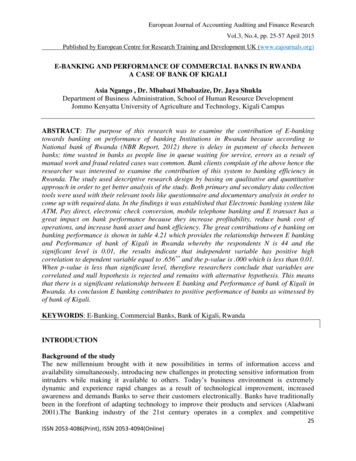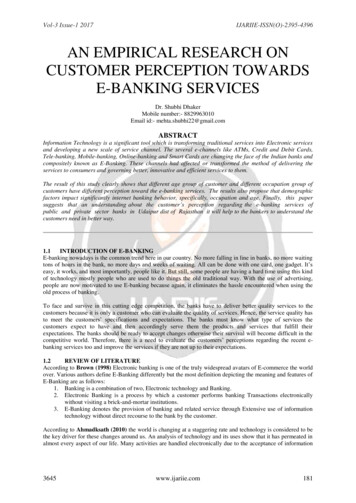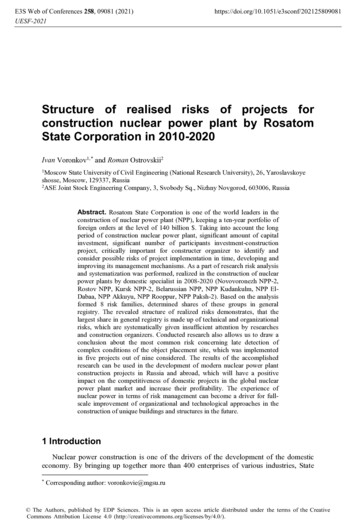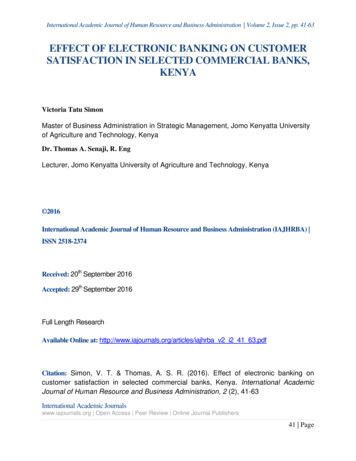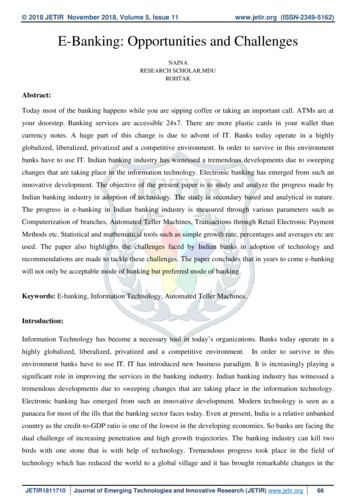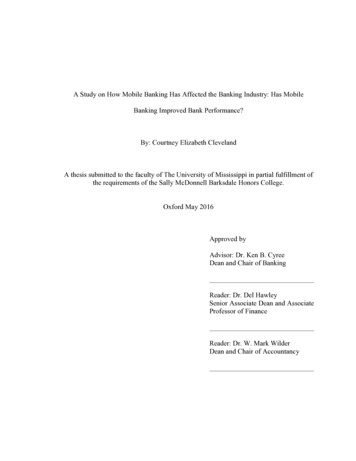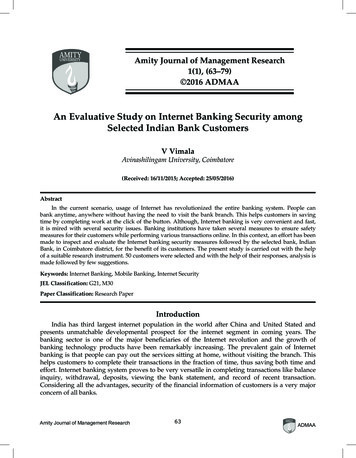
Transcription
IRJCInternational Journal of Marketing, Financial Services & Management ResearchVol.1 Issue 9, September 2012, ISSN 2277 3622RISKS IN E-BANKING AND THEIR MANAGEMENTPROF. VIRENDER SINGH SOLANKI**Institute of Productivity & Management,Meerut.ABSTRACTInternet banking and other modes of e-banking have been a blessing for banking as far asspeed, convenience and cost of delivery is concerned, but alongside it has brought manyrisks. It has also brought about a new orientation to risks and even new forms of risks.Technology plays a significant part both as source and tool for control of risks. Because ofrapid changes in information technology, there is no finality either in the types of risks ortheir control measures. E- Banking may soon convert from a complementary to the mainprovider of financial services and products. Consequently, a possible failure of a bankentering this sector can have various consequences on its future position in the market. Thebank‟s strategy should be readjusted so that it meets the new challenges with risk balance.KEYWORDS: E – banking, risks, operational, money laundering, cross borders, firewalls,customer education, auditing.THE RISKSThe growth of electronic banking has created a new basis with regard to the degree ofexposure to the risk and therefore consequently the need of not only a differentiatedregulating frame, but also mechanisms of monitoring to be formed, which has already begunto be shaped in the fields of Basle Committee of Banking Supervision.The business risk is the risk of not being able to achieve the business targets due toinappropriate strategies, inadequate resources or changes in the economic or competitive164The rapid spread of Internet banking all over the world is its acceptance as an extremely costeffective delivery channel of banking services as compared to other existing channels.However, internet is not an unmixed blessing to the banking sector. Along with reduction incost of transactions, it has also brought about a new orientation to risks and even new formsof risks to which banks conducting I-banking expose themselves. Regulators and supervisorsall over the world are concerned that while banks should remain efficient and cost effective,they must be conscious of different types of risks this form of banking entails and havesystems in place to manage the same. An important and distinctive feature is that technologyplays a significant part both as source and tool for control of risks. Because of rapid changesin information technology, there is no finality either in the types of risks or their controlmeasures. Both evolve continuously. The thrust of regulatory action in risk control has beento identify risks in broad terms and to ensure that banks have minimum systems in place toaddress the same and that such systems are reviewed on a continuous basis in keeping withchanges in ION
IRJCInternational Journal of Marketing, Financial Services & Management ResearchVol.1 Issue 9, September 2012, ISSN 2277 3622environment. It has to do with the ability the credit institution has in order to achieve theoperational objectives by exploiting the available opportunities in the market. The bigchanges on the banking sector and the adoption of fast paced evolving technology alsochange the traditional strategic risks. A bank that will rush into the adoption of newtechnologies so that it is rendered pioneer is risking losing its investment as informationsystems lose their value in very short time interval. Moreover, there is the risk of extensiveinvestment in particular products or services, which will not become acceptable by the endusers. On the other hand, if it maintains a more conservative attitude there is the risk ofbecoming last, in an environment where the competition is moving fast and strengthens itsplace in the market. Internet banking may soon convert from a complementary to the mainprovider of financial services and products. Consequently, a possible failure of a bankentering this sector, can have various consequences on its future position in the market,especially when the competition of the banks, which are clearly connected with the I-bankingand do not have any physical substance (virtual banks), is already given.THE RISKS IN E-BANKING ARE AS FOLLOWSOperational riskSecurity riskSystem architecture & design riskReputational riskLegal risksMoney laundering riskStrategic riskOther risk165Operations risk arises from fraud, processing errors, system disruptions, or otherunanticipated events resulting in the institution‟s inability to deliver products or services.This risk exists in each product and service offered. The level of transaction risk is affectedby the structure of the institution‟s processing environment, including the types of servicesoffered and the complexity of the processes and supporting technology. In most instances, ebanking activities will increase the complexity of the institution‟s activities and the quantityof its operations risk, especially if the institution is offering innovative services that have notbeen standardized. Since customers expect e-banking services to be available 24 hours a day,7 days a week, financial institutions should ensure their e-banking infrastructures containsufficient capacity and redundancy to ensure reliable service availability.www.indianresearchjournals.com1. OPERATIONAL RISK
IRJCInternational Journal of Marketing, Financial Services & Management ResearchVol.1 Issue 9, September 2012, ISSN 2277 3622BANKS FACE THREE MAIN TYPES OF OPERATIONS RISK(I)VOLUME FORECASTSAccurate volume forecasts have proved difficult - One of the key challenges encountered bybanks in the Internet environment is how to predict and manage the volume of customers thatthey will obtain. Many banks going on-line have significantly misjudged volumes. When abank has inadequate systems to cope with demand it may suffer reputational and financialdamage, and even compromises in security if extra systems that are inadequately configuredor tested are brought on-line to deal with the capacity problems.As a way of addressing this risk, banks should:undertake market research,adopt systems with adequate capacity and scalability,undertake proportionate advertising campaigns,Ensure that they have adequate staff coverage and develop a suitable businesscontinuity plan.In brief, this is a new area, nobody knows all the answers, and banks need to exerciseparticular caution.(II)MANAGEMENT INFORMATION SYSTEMSOperational risk can also arise from fraud. A financial institution‟s exposure to operationalrisk from fraud is the risk that a wrongful or criminal deception will lead to a financial lossfor one of the parties involved. Currency and checks are more vulnerable to loss or directtheft, whereas fraud is the primary concern in bank card payment transactions.Operational risk controls should include information system, procedural, administrative, andlegal measures to prevent or limit financial loss as a result of operational risk. Systemmeasures include monetary and time limits (per transaction, per payment instrument, per166Operational risk is the risk of incurring financial loss due to human or technical errors andfraud. Operational risk can arise from the failure to follow or complete one or more steps inthe prescribed authorization process. Operational risk includes the risks associated with thefailure of communications, the breakdown of data transport or processing, internal controlsystem deficiencies, human errors, or management failure. As a result, the financialinstitution could experience delays or disruptions in processing, clearing, and settling retailpayment transactions, that could lead to credit and liquidity problems at other omBanks may have difficulties in obtaining adequate management information to monitor theire-service, as it can be difficult to establish/configure new systems to ensure that sufficient,meaningful and clear information is generated. Such information is particularly important in anew field like e-banking. Banks are being encouraged by the FSA (Financial ServicesAuthorities) to ensure that management have all the information that they require in a formatthat they understand and that does not cloud the key information with superfluous details.
IRJCInternational Journal of Marketing, Financial Services & Management ResearchVol.1 Issue 9, September 2012, ISSN 2277 3622client), and personal authentication and encryption techniques to ensure the authenticity ofthe payer and transaction information integrity. Additional controls include the use ofcertified tamper-resistant equipment e.g., EFT/POS (electronic fund transfer/ Point of sales)terminals.Procedural measures include appropriate dual custody and separation of duties for criticalpayment transaction processing and accounting tasks, payment data verification, clear errorprocessing and escalation procedures, and confidential and tamper-resistant mailingprocedures for bank cards and other sensitive material. Administrative measures shouldinclude IT audit coverage of operational controls, legal controls (including regulatorycompliance and agreements), and personnel issues associated with staffing and training.(III) OUTSOURCINGFinally, a significant number of banks offering e-banking services outsource related businessfunctions, e.g. security, either for reasons of cost reduction or, as are often the case in thisfield, because they do not have the relevant expertise in-house. Outsourcing a significantfunction can create material risks by potentially reducing a bank‟s control over that function.Outsourcing is of course neither new nor unmanageable but banks should be mindful onoutsourcing, which addresses these risks.2. SECURITY RISKUnless specifically protected, all data / information transfer over the Internet can bemonitored or read by unauthorized persons. There are programs such as „sniffers‟ which canbe set up at web servers or other critical locations to collect data like account numbers,passwords, account and credit card numbers. Data privacy and confidentiality issues arerelevant even when data is not being transferred over the net.Data residing in web servers or even banks‟ internal systems are susceptible to corruption ifnot properly isolated through firewalls from Internet. Proper access control and technological167In addition to external attacks banks are exposed to security risk from internal sources e.g.employee fraud. Employees being familiar with different systems and their weaknessesbecome potential security threats in a loosely controlled environment. They can manage toacquire the authentication data in order to access the customer accounts causing losses to thebank.www.indianresearchjournals.comSecurity risk arises on account of unauthorized access to a bank‟s critical information storeslike accounting system, risk management system, portfolio management system, etc. Abreach of security could result in direct financial loss to the bank. For example, hackersoperating via the Internet could access, retrieve and use confidential customer informationand also can implant virus. This may result in loss of data, theft of or tampering withcustomer information, disabling of a significant portion of bank‟s internal computer systemthus denying service, cost of repairing these etc. Other related risks are loss of reputation,infringing customers‟ privacy and its legal implications. Thus, access control is of paramountimportance. Controlling access to banks‟ system has become more complex in the Internetenvironment which is a public domain and attempts at unauthorized access could emanatefrom any source and from anywhere in the world with or without criminal intent. Attackerscould be hackers, unscrupulous vendors, disgruntled employees or even pure thrill seekers.
IRJCInternational Journal of Marketing, Financial Services & Management ResearchVol.1 Issue 9, September 2012, ISSN 2277 3622tools to ensure data integrity is of utmost importance to banks.Identity of the person making a request for a service or a transaction as a customer is crucialto legal validity of a transaction and is a source of risk to a bank. A computer connected toInternet is identified by its IP (Internet Protocol) address. There are methods available tomasquerade one computer as another, commonly known as „IP Spoofing‟. Likewise useridentity can be misrepresented. Hence, authentication control is an essential security step inany e-banking system.Non-repudiation involves creating a proof of communication between two parties; say thebank and its customer, which neither can deny later. Banks‟ system must be technologicallyequipped to handle these aspects which are potential sources of risk. Banks should have:1.A strategic approach to information security, building best practice security controlsinto systems and networks as they are developed2.A proactive approach to information security, involving active testing of systemsecurity controls (e.g. penetration testing), rapid response to new threats andvulnerabilities and regular review of market place developments3Sufficient staff with information security expertise4.Active use of system based security management and monitoring tools.5.Strong business information security controls168Appropriate system architecture and control is an important factor in managing various Kindsof operational and security risks. A bank faces the risk that the systems it chooses are notwell designed or implemented. For example, a bank is exposed to the risk of an interruptionor slow-down of its existing systems if the electronic banking or electronic money system itchooses is not compatible with user requirements. Many banks are likely to rely on outsideservice providers and external experts to implement, operate, and support portions of theirelectronic money and electronic banking activities. Such reliance may be desirable because itallows a bank to outsource aspects of the provision of electronic banking and electronicmoney activities that it cannot provide economically itself. However, reliance on outsourcingexposes a bank to operational risks. Service providers may not have the requisite expertise todeliver services expected by the bank, or may fail to update their technology in a timelymanner. A service provider‟s operations could be interrupted due to system breakdowns orfinancial difficulties, jeopardizing a bank‟s ability to deliver products or services. The rapidpace of change that characterizes information technology presents banks with the risk ofsystems obsolescence. For example, computer software that facilitates the use of electronicbanking and electronic money products by customers will require updating, but channels fordistributing software updates pose risks for banks in that criminal or malicious individualscould intercept and modify the software. In addition, rapid technological change can meanthat staff may fail to understand fully the nature of new technology employed by the bank.This could result in operational problems with new or updated systems.www.indianresearchjournals.com3. SYSTEM ARCHITECTURE AND DESIGN RISK
IRJCInternational Journal of Marketing, Financial Services & Management ResearchVol.1 Issue 9, September 2012, ISSN 2277 36224. REPUTATIONAL RISKReputational risk is the risk of getting significant negative public opinion, which may resultin a critical loss of funding or customers. Such risks arise from actions which cause majorloss of the public confidence in the banks' ability to perform critical functions or impair bankcustomer relationship. It may be due to banks‟ own action or due to third party action. Themain reasons for this risk may be system or product not working to the expectations of thecustomers, significant system deficiencies, significant security breach (both due to internaland external attack), inadequate information to customers about product use and problemresolution procedures, significant problems with communication networks that impaircustomers‟ access to their funds or account information especially if there are no alternativemeans of account access. Such situation may cause customer-discontinuing use of product orthe service. Directly affected customers may leave the bank and others may follow if theproblem is publicized.Other reasons include losses to similar institution offering same type of services causingcustomer to view other banks also with suspicion, targeted attacks on a bank like hackerspreading inaccurate information about bank products, a virus disturbing bank‟s systemcausing system and data integrity problems etc.Possible measures to avoid this risk are to test the system before implementation, backupfacilities, contingency plans including plans to address customer problems during systemdisruptions, deploying virus checking, deployment of ethical hackers for plugging theloopholes and other security measures.It is significant not only for a single bank but also for the system as a whole. Under extremecircumstances, such a situation might lead to systemic disruptions in the banking system.Thus the role of the regulator becomes even more important as not even a single bank can beallowed to fail.Another legal risk is related with the protection of the customers‟ personal data. Bad use bythe bank personnel or by exterior malignant intruders can expose a bank in serious legal risks.It is possible that the intruders acquire access in the databases of the banks and use the data ofcustomers in order to commit a fraud. In this case a legal risk is created by the bad or notcertified use of customers‟ data. The legal risks, in which the financial institutions will beexposed from the use of electronic banking, are expected to increase because of theuncertainty that characterizes the wider legal framework and the specific lawful regulationsof transactions through an open electronic network as the internet is. The uncertainty with169Legal risk is the risk of non-compliance with legal or regulatory requirements. The legal risksare directly related to the electronic banking and they are increased as its use is extended.They mainly stem from the uncertainty that exists in the legal – regulative frameworkconcerning the electronic banking. In most countries an explicit regulating framework doesnot exist and this is owed to the little experience regarding the sector of electronic banking.The problem becomes even bigger when a bank offers its electronic services to othercountries as well, since a unified legal frame in international level does not exist. Eachcountry puts its own rules into effect and it is difficult for a bank to constantly adapt itsservices and to be acquainted with all the laws that are in effect in every country.www.indianresearchjournals.com5. LEGAL /COMPLIANCE RISK
IRJCInternational Journal of Marketing, Financial Services & Management ResearchVol.1 Issue 9, September 2012, ISSN 2277 3622regard to the validity of transactions, the protection of personal data, the involuntaryconsumer‟s exposure to foreign jurisdiction, the tax evasion, the laundering of money, theelectronic fraud but also the legal responsibility in case a system collapses, increase theexposure to the legal regulatory risks.In terms of the European Union, a regulating frame has been developed that is concernedwith questions such as the electronic (digital) signatures, the distant rendering of financialservices, as well as the Directive on the electronic commerce.A customer inadequately informed about his rights and obligations, may not take properprecautions in using Internet banking products or services, leading to disputed transactions,unwanted suits against the bank or other regulatory sanctions. In the enthusiasm of enhancingcustomer service, bank may link their Internet site to other sites also. This may cause legalrisk. Further, a hacker may use the linked site to defraud a bank customer.Compliance and legal issues arise out of the rapid growth in usage of e-banking and thedifferences between electronic and paper-based processes. E-banking is a new deliverychannel where the laws and rules governing the electronic delivery of certain financialinstitution products or services may be ambiguous or still evolving. Specific regulatory andlegal challenges include:Laws and regulations governing consumer transactions require specific types of disclosures,notices, or record keeping requirements. These requirements also apply to e-banking, andReserve Bank of India continues to update consumer laws and regulations to reflect theimpact of e-banking and on-line customer relationships. Some of the legal requirements andregulatory guidance that frequently apply to e-banking products and services have beenissued by R.B.I. in its notification on 14th June, 2001, which were the findings of a workinggroup on Internet Banking. These guidelines are available on the web site of RBI.As Internet banking transactions are conducted remotely banks may find it difficult to applytraditional method for detecting and preventing undesirable criminal activities. Application ofmoney laundering rules may also be inappropriate for some forms of electronic payments.Thus banks expose themselves to the money laundering risk. This may result in legalsanctions for non-compliance with “know your customer” laws.170Money laundering is the practice of engaging in financial transactions in order to conceal theidentity, source, and/or destination of money, and is a main operation of the undergroundeconomy. Money laundering is called what it is because that perfectly describes what takesplace - illegal, or dirty, money is put through a cycle of transactions, or washed, so that itcomes out the other end as legal, or clean, money. In other words, the source of illegallyobtained funds is obscured through a succession of transfers and deals in order that thosesame funds can eventually be made to appear as legitimate income. Every financial institutionis charged with the responsibility of developing policies and procedures to combat moneylaundering, which includes the duty to be aware of trends and adaptations in the methods bywhich money laundering is carried out. The most difficult aspect of this responsibility is afinancial organization‟s ability to anticipate new criminal behavior and to proactivelyimplement protocols before the criminal behavior occurs.www.indianresearchjournals.com6. MONEY LAUNDERING RISK
IRJCInternational Journal of Marketing, Financial Services & Management ResearchVol.1 Issue 9, September 2012, ISSN 2277 3622To avoid this, banks need to design proper customer identification and screening techniques,develop audit trails, and conduct periodic compliance reviews, frame policies and proceduresto spot and report suspicious activities in Internet transactions.7. STRATEGIC RISKOn strategic risk E-banking is relatively new and, as a result, there can be a lack ofunderstanding among senior management about its potential and implications. People withtechnological, but not banking, skills can end up driving the initiatives. E-initiatives canspring up in an incoherent and piecemeal manner in firms. They can be expensive and canfail to recoup their cost. Furthermore, they are often positioned as loss leaders (to capturemarket share), but may not attract the types of customers that banks want or expect and mayhave unexpected implications on existing business lines.Banks should respond to these risks by having a clear strategy driven from the top and shouldensure that this strategy takes account of the effects of e-banking, wherever relevant. Such astrategy should be clearly disseminated across the business, and supported by a clear businessplan with an effective means of monitoring performance against it.Poor e-banking planning and investment decisions can increase a financial institution‟sstrategic risk. Early adopters of new e-banking services can establish themselves asinnovators who anticipate the needs of their customers, but may do so by incurring highercosts and increased complexity in their operations. Conversely, late adopters may be able toavoid the higher expense and added complexity, but do so at the risk of not meeting customerdemand for additional products and services.HERE ARE A FEW SIMPLE SECURITY TIPS TO KEEP IN MIND, FOR A SAFERONLINE EXPERIENCEDo not provide any personal information. Be very suspicious of any e-mail from abusiness or person that asks for your password, passport number etc.Review the link provided to ensure it leads to a valid website.Use a strong password.Change your PIN / password often.Do not visit suspicious sites. If you suspect that a website is not what it purports to be,leave the site immediately.Be alert for scam e-mails. These may appear to come from a trusted business orfriend, but are actually designed to trick you into downloading a virus or jumping to afraudulent website and disclosing sensitive information.171Act quickly if you suspect fraud. If you believe someone is trying to commit fraud bypretending to be your bank, notify the financial institution immediately.www.indianresearchjournals.comReview the sender‟s e-mail address to verify that it is from a valid e- mail account.
IRJCInternational Journal of Marketing, Financial Services & Management ResearchVol.1 Issue 9, September 2012, ISSN 2277 3622Open e-mails only when you know the sender. Be especially careful about opening emails with attachments.Make sure your home computer has the most current anti-virus software. Install apersonal firewall to help prevent unauthorized access to your home computer.Monitor your transactions. Review your order confirmations, Credit Card and BankStatements as soon as you receive them.8. OTHER RISKSTraditional banking risks such as credit risk, liquidity risk, interest rate risk, and market riskmay also arise from electronic banking and electronic money activities, though their practicalconsequences may be of a different magnitude for banks and supervisors than operational,reputational, and legal risks. This may be particularly true for banks engaged in a variety ofbanking activities, as compared to banks or bank subsidiaries that specialize in electronicmedium.CREDIT RISKGenerally, a financial institution‟s credit risk is not increased by the mere fact that a loan isoriginated through an e-banking channel. The following aspects of on-line loan originationand approval tend to make risk management of the lending process more challenging.Verifying the customer‟s identity for on-line credit applications and executing anenforceable contract;Monitoring and oversight of third-parties doing business as agents or on behalf of thefinancial institution;Valuing collateral and perfecting liens over a potentially wider geographic area;LIQUIDITY RISKSLiquidity risk is the risk arising from a bank‟s inability to meet its obligations when theycome due, without incurring unacceptable losses, although the bank may ultimately be able tomeet its obligations. Liquidity risk may be significant for banks that specialize in electronicmoney activities if they are unable to ensure that funds are adequate to cover redemption andsettlement demands at any particular time. In addition, failure to meet redemption demands ina timely manner could result in legal action against the institution, and lead to reputationaldamage.172Credit risk is the risk that a counter party will not settle an obligation for full value, eitherwhen due or at any time thereafter. Banks engaging in electronic banking activities mayextend credit via non-traditional channels, and expand their market beyond traditionalgeographic boundaries. Inadequate procedures to determine the credit worthiness ofborrowers applying for credit via remote banking procedures could heighten credit risk forbanks. Banks engaged in electronic bill payment programs may face credit risk if a third partyintermediary fails to carry out its obligations with respect to payment.www.indianresearchjournals.comCollecting loans from individuals over a potentially wider geographic area.
IRJCInternational Journal of Marketing, Financial Services & Management ResearchVol.1 Issue 9, September 2012, ISSN 2277 3622INTEREST RATE RISKIt refers to the exposure of a bank‟s financial condition to adverse movements in interestrates. Banks specializing in the provision of electronic money may face significant interestrate risk to the extent adverse movements in interest rates decrease the value of assets relativeto electronic money liabilities outstanding.MARKET RISKMarket risk is the risk of losses in on- and off-balance sheet positions arising frommovements in market prices, including foreign exchange rates. Banks accepting foreigncurrencies in payment for electronic money are subject to this type of risk.BUSINESS RISKSBusiness risks are also significant. Given the newness of e-banking, nobody knows muchabout whether e-banking customers will have different characteristics from the traditionalbanking customers. They may well have different characteristics e.g. I want it all and I wantit now. This could render existing score card models inappropriate, thus resulting in eitherhigher rejection rates or inappropriate pricing to cover the risk. Banks may not be able toassess credit quality at a distance as effectively as they do in face to face circumstances. Itcould be more difficult to assess the nature and quality of collateral security offered at adistance, especially if it is located in an area the bank is unfamiliar with (particularly if this isoverseas). Furthermore as it is difficult to predict customer volumes and the stickiness of edeposits (things which could lead either to rapid flows in or out of the bank) it could be verydifficult to manage liquidity.RISK MANAGEMENTFor an increasing number of banks there may be
The business risk is the risk of not being able to achieve the business targets due to inappropriate strategies, inadequate resources or changes in the economic or competitive . IRJC International Journal of Marketing, Financial Services & Management Research Vol.1 Issue 9, September 2012, ISSN 2277 3622 .
